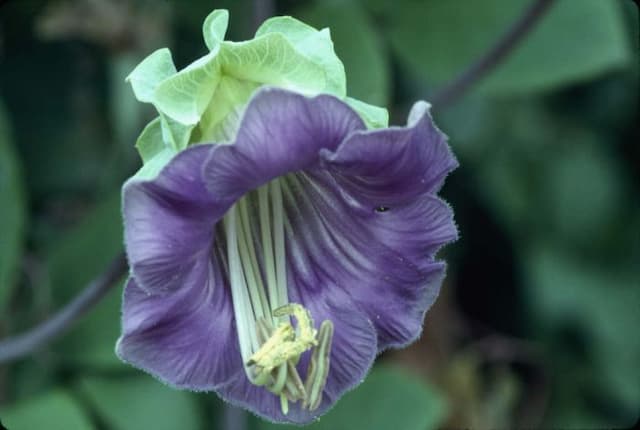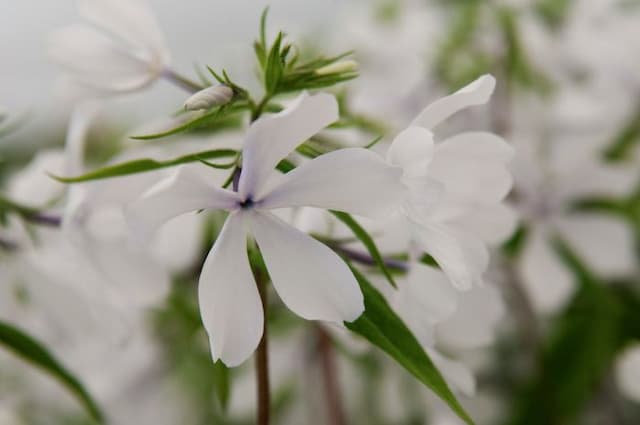Creeping Phlox Phlox subulata 'Red Wings'

ABOUT
The Phlox subulata 'Red Wings', commonly known as the moss phlox, features a lush carpet of dense, needle-like foliage. During bloom time, it becomes a vibrant tapestry of reddish-pink flowers. Each individual blossom displays delicate, five-petaled flowers with a darker center that often appears as a small eye. The overall effect of the flowers is quite striking as they densely cover the foliage in a showy display. The plant's leaves are small and narrow, contributing to its moss-like appearance, and they remain evergreen, providing year-round interest even when the plant isn't in bloom. The moss phlox is praised for its ability to create a vivid ground cover, spilling over rockeries or cascading down slopes, and its blossoms are a favorite for attracting pollinators like butterflies.
About this plant
 Names
NamesSynonyms
Moss Phlox, Creeping Phlox, Mountain Phlox, Moss Pink, Ground Pink, Moss Pinks, Dwarf Phlox.
Common names
Phlox subulata 'Red Wings'.
 Toxicity
ToxicityTo humans
Creeping phlox is not known to be toxic to humans. Therefore, if ingested in typical amounts found in a garden setting, it should not cause any significant symptoms of poisoning or serious health consequences.
To pets
Creeping phlox is not considered toxic to pets either. Ingesting parts of this plant is unlikely to result in poisoning or severe health issues for domestic animals such as dogs and cats. However, it is always recommended to monitor pets if they ingest plants since individual reactions can vary and gastrointestinal upset can sometimes occur even with non-toxic plants.
 Characteristics
CharacteristicsLife cycle
Perennials
Foliage type
Evergreen
Color of leaves
Green
Flower color
Red
Height
6 inches (15 cm)
Spread
20 inches (50 cm)
Plant type
Creeper
Hardiness zones
3-9
Native area
North America
Benefits
 General Benefits
General Benefits- Ground cover: Phlox subulata 'Red Wings' is well-regarded for its ability to act as a dense ground cover, reducing soil erosion.
- Attracts pollinators: Offers nectar-rich flowers that attract butterflies and bees, supporting local ecosystems.
- Drought tolerance: Once established, it has a good tolerance for dry conditions, requiring minimal watering.
- Spring Bloomer: Provides vibrant red flowers in spring, offering early-season color in gardens.
- Low maintenance: Requires minimal care once established, with no need for regular pruning or deadheading.
- Cold hardy: Capable of withstanding cold temperatures, making it suitable for a variety of climates.
- Deer resistant: Less attractive to deer, decreasing the likelihood of plant damage from wildlife.
- Rapid grower: Spreads quickly, filling in areas and creating a carpet of color in a relatively short time span.
- Easy to propagate: Can be easily propagated through division, making it cost-effective for large plantings or sharing with others.
- Versatile use: Suitable for rock gardens, borders, and slopes, as well as general garden ground cover.
 Medical Properties
Medical PropertiesThis plant is not used for medical purposes.
 Air-purifying Qualities
Air-purifying QualitiesThis plant is not specifically known for air purifying qualities.
 Other Uses
Other Uses- Creeping Phlox can be used in miniature gardens or fairy gardens due to its small size and texture which adds whimsical charm to these tiny themed landscapes.
- It's an ideal plant for use in living roofs or green roofs, where its drought tolerance and low maintenance can be beneficial attributes.
- Can be used for creating colorful patterns or "living" paintings when planted in large numbers across a landscape, much like a ground-level mosaic.
- Works effectively as a natural weed suppressant due to its dense growth, reducing the need for chemical herbicides in the garden.
- Can be planted on steep slopes or banks to help prevent soil erosion with its mat-forming roots that hold the soil in place.
- Useful in xeriscaping, a landscape method that reduces the need for irrigation, as Creeping Phlox is drought-tolerant once established.
- May be used to add seasonal interest to container gardens, where it can spill over the edges for a soft, flowing effect.
- Creeping Phlox can be paired with spring bulbs to provide a carpet of foliage after the bulbs have flowered and died back.
- Perfect for attracting pollinators such as bees and butterflies to the garden, promoting biodiversity.
- When used as a ground cover around mailboxes or along sidewalks, it can provide a burst of color and help highlight these areas.
Interesting Facts
 Feng Shui
Feng ShuiThe Creeping Phlox is not used in Feng Shui practice.
 Zodiac Sign Compitability
Zodiac Sign CompitabilityThe Creeping Phlox is not used in astrology practice.
 Plant Symbolism
Plant Symbolism- Harmony and Unity: The dense growth and clustering of its flowers symbolize people coming together in harmony and solidarity.
- New Beginnings: As a perennial that reemerges every spring, red moss phlox signifies new opportunities and fresh starts.
- Agreement: Because of the uniformity of the flowers, the plant often represents consensus and mutual understanding.
- Sweet Dreams: In some traditions, phlox is believed to encourage pleasant dreams and a peaceful sleep, relating possibly to its gentle appearance.
- Proposal: Red moss phlox, with its lush crimson blooms, could symbolize a passionate proposal or an offer of love.
 Water
WaterCreeping Phlox requires moderate watering, especially when it's establishing roots or during prolonged dry spells. Typically, water about once a week, applying about 1 inch of water to the soil around the plant. Ensure the soil is well-draining to prevent waterlogging. During the hot summer months, you may need to water more frequently, while in cooler temperatures, water less often. It's crucial to avoid overhead watering to prevent disease; instead, water at the base of the plant. During winter, watering can be reduced significantly, only when the ground is not frozen.
 Light
LightCreeping Phlox thrives best in full sunlight but can tolerate partial shade. Plant it in a location where it can receive at least six hours of direct sunlight daily. This exposure ensures vibrant blooms and healthy growth. While it can manage in some shade, too little light may lead to fewer flowers and leggy plants.
 Temperature
TemperatureCreeping Phlox is cold hardy and can tolerate minimum temperatures down to -20°F, while it grows ideally in temperatures ranging from 60°F to 85°F. It can survive brief periods of higher temperatures but consistently high heat may stress the plant. Ensure the plant has adequate moisture during extreme temperature fluctuations.
 Pruning
PruningCreeping Phlox benefits from pruning to promote a bushier growth habit and to maintain its appearance. Prune after the blooming season, cutting back flowering stems to encourage a second bloom and to prevent it from becoming too woody. Annual or biannual pruning can keep plants vigorous and flowering abundantly. The best time for pruning is late spring or early summer, after the main flush of flowers.
 Cleaning
CleaningAs needed
 Soil
SoilCreeping Phlox thrives in well-drained soil with a pH of 6.0 to 8.0. For optimal growth, mix garden soil with compost and a bit of sand or gravel to enhance drainage.
 Repotting
RepottingCreeping Phlox is not commonly repotted as it is a ground cover plant; it prefers being divided every few years in spring or fall instead.
 Humidity & Misting
Humidity & MistingCreeping Phlox is adapted to outdoor conditions and does not require any specific humidity levels; it tolerates a range of ambient humidity.
 Suitable locations
Suitable locationsIndoor
Grow in bright light, in a well-draining soil mix.
Outdoor
Plant in sun to part shade, in well-draining soil.
Hardiness zone
3-9 USDA
 Life cycle
Life cyclePhlox subulata 'Red Wings', commonly known as Creeping Phlox or Moss Phlox, begins its life as a seed which germinates in late spring to early summer, requiring well-drained soil and some moisture. The seedling stage follows, where the plants develop root systems and foliage, staying close to the ground and spreading outwards. During the vegetative stage, Creeping Phlox establishes a dense mat of semi-evergreen foliage and can be propagated by division. As it enters the blooming stage, typically in early spring, it showcases a vibrant display of crimson, star-shaped flowers that attract pollinators. After pollination, the plant sets seed which can be dispersed by wind or wildlife, starting a new generation. Throughout its life, Creeping Phlox undergoes periods of growth and dormancy, usually retreating in the colder months and reemerging with vigorous growth in the spring.
 Propogation
PropogationPropogation time
Spring-Early Summer
The Moss Phlox 'Red Wings' is commonly propagated through stem cuttings, ideally during the late spring or early summer. This method involves taking a healthy, non-flowering stem of about 4 to 6 inches (10 to 15 cm) long from the parent plant and removing the leaves from the lower half of the cutting. The cut end is then dipped into rooting hormone powder to enhance root growth and planted into a well-draining potting mix. The soil should be kept consistently moist but not soggy, and the cuttings should be placed in a bright area with indirect sunlight. Roots typically begin to develop within a few weeks, after which the new plants can be transplanted into the garden or into individual pots.









